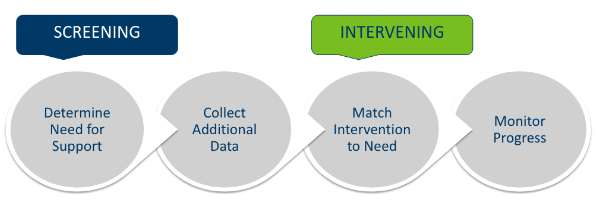TIER 2 & 3
What Is Instructional Intervention?
Tier 2 Instruction Overview
Definition:
Tier 2 instruction is a short-term, targeted intervention for students who need extra support. It provides high-quality, research-based help to a small group of students (10-20%) so they can succeed academically, socially, and emotionally. This support is given in addition to regular classroom instruction, not as a replacement.
Key Features:
Targeted Intervention: A portion of students receive Tier 2 instruction in order to address deficits in targeted areas. Interventions are strategically designed to meet individual student needs in specified areas.
Progress-Monitoring: Student progress on targeted skills in response to Tier 2 interventions is regularly monitored to determine how well the student is responding to the intervention. Instruction is subsequently adjusted and modified based on the progress monitoring data. Teaching staff regularly communicate progress with families through formal meetings (Individual Reading Improvement Plans, Parent/Teacher Conferences, Individualized Education Plans, and Student Assistance Team meetings) and informal communications (emails, letters, messages).
Intervention Variety: Tier 2 interventions vary from Tier 1 instruction in frequency, group size, intensity, and/or instructional delivery/technique. These interventions can be provided by a variety of trained staff members.
Evidence-Based Practices: Intervention strategies are supported by research and shown to be effective for students working on targeted skills.
Collaborative Planning: Staff meet regularly to monitor student progress and discuss needed supports and interventions. Team-based decisions are made using current student data and staff member feedback.
Alignment with Tier 1: Tier 2 interventions are intentionally aligned with Tier 1 instruction to ensure coherence in curriculum, expectations, and learning targets. Intervention is not a replacement for core instruction but a strategic extension of it.
Fidelity of Implementation: Interventions are implemented as intended, using clearly defined protocols and training. Ongoing support and coaching ensure interventions are delivered consistently and effectively across classrooms and staff. District Leadership Teams, Building Leadership Teams, Grade Level/Subject Area Teams, and Student Assistant Teams will communicate regularly to support implementation.
Instructional Effectiveness: The effectiveness of Tier 2 interventions is evaluated by comparing student performance data to proficiency standards for the student’s grade level. These proficiency standards and student progress are regularly communicated to relevant stakeholders, including families and staff members. Tier 2 interventions may be modified or terminated based on student progress.
Tier 3 Instruction Overview
Definition:
Tier 3 instruction is the high-quality, evidence-based, high-intensity intervention instruction provided to a limited number of students. It emphasizes highly specialized interventions to ensure that identified students (less than 10% of the student population) achieve academic, social-emotional, and behavioral success when Tier 1 and Tier 2 interventions have not been successful. Tier 3 intervention is provided in addition to Tier 1 and Tier 2 interventions, not as a replacement for Tier 1 and Tier 2 instruction. Tier 3 interventions may include, but are not limited to, special education services.
Key Features:
Highly Specialized Intervention: A portion of students receive Tier 3 instruction in order to address significant deficits in targeted areas. Interventions are strategically designed to meet individual student needs in specified areas.
Progress-Monitoring: Student progress on targeted skills in response to Tier 3 interventions is regularly monitored to determine how well the student is responding to the targeted intervention. Instruction is subsequently adjusted and modified based on progress monitoring data. Teaching staff regularly communicate progress with families through formal meetings (Individual Reading Improvement Plans, Parent/Teacher Conferences, Individualized Education Plans, and Student Assistance Team meetings) and informal communications (emails, letters, messages).
Intervention Variety: Tier 3 interventions increased in intensity from Tier 1 and Tier 2 instruction in frequency, group size, and/or instructional delivery/technique. These interventions can be provided by a variety of trained staff members, including but not limited to special education teachers and staff.
Evidence-Based Practices: Intervention strategies are supported by research and shown to be effective for students working on targeted skills.
Collaborative Planning: Staff meet regularly to monitor student progress and discuss needed supports and interventions. Team-based decisions are made using current student data and staff member feedback.
Alignment with Tier 1: Tier 3 interventions are intentionally aligned with Tier 1 instruction to ensure coherence in curriculum, expectations, and learning targets. Intervention is not a replacement for core instruction but a strategic extension of it.
Fidelity of Implementation: Interventions are implemented as intended, using clearly defined protocols and training. Ongoing support and coaching ensure interventions are delivered consistently and effectively across classrooms and staff. District Leadership Teams, Building Leadership Teams, Grade Level/Subject Area Teams, and Student Assistant Teams will communicate regularly to support implementation.
Instructional Effectiveness: The effectiveness of Tier 3 interventions is evaluated by comparing student performance data to proficiency standards for the student’s grade level. These proficiency standards and student progress are regularly communicated to relevant stakeholders, including families and staff members. Tier 3 interventions may be modified or terminated based on student progress.
Process for Determining Need for Tier 2/3 Support

Universal Screening
Universal screening assessments are given to students three times per school year (Fall, Winter, Spring) in grades JK-8th. Students who perform below the 30th percentile on the universal screener are flagged for diagnostic assessments.
Diagnostic Assessments
Diagnostic assessments help identify specific deficit areas for targeted Tier 2 instruction. These assessments, combined with classroom assessments and teacher observations, help staff create an intervention plan for students. This intervention plan may include Tier 2 and/or Tier 3 supports, depending on the identified needs of the student.
Guiding questions for data-based decision-making at Tiers 2 and 3:
How many students are receiving support at each Tier in reading? Math? Social-emotional and behavioral functioning? Other areas?
Of those students who performed below benchmarks during the previous screening period, what proportion have continued to perform below benchmarks?
Is programming having the desired impact on students at each tier?
Do we have the right supports in place?
Do we have staff in the correct assignments to support students?
Diagnostic Tools
The table below provides a list of possible diagnostic assessments that may be used for students who are flagged on universal screeners. Individual assessments will be selected based on student needs in identified areas.
Tool | Domain | Grades | Frequency |
Math Recovery Assessment | Math | JK-5 | 3 times per year |
Decoding Inventory | ELA | JK-5 | 3 times per year |
Phonemic Awareness Assessment | ELA | JK-5 | 3 times per year |
CBM-R | ELA | 1-5 | 3 times per year |
Progress Monitoring Tools
The table below provides a list of possible progress monitoring assessments that may be used for students receiving intervention. Individual assessments will be selected based on student needs in identified areas.
Tool | Domain | Grades | Frequency |
Fastbridge | Reading, Math | JK-5 | Varies (bi-weekly) |
Brigance | Reading, Written Expression, Math | K-8 | 2-3 times per year |
Decoding Inventories | ELA | JK-5 | Weekly or bi-weekly |
Phonemic Awareness | ELA | JK-5 | Weekly or bi-weekly |
CBM-R | ELA | 1-5 | Weekly or bi-weekly |
Math Recovery Assessment | Math | JK-5 | Weekly or bi-weekly |
Frequency Data | Behavior | JK-5 | Weekly or bi-weekly |
